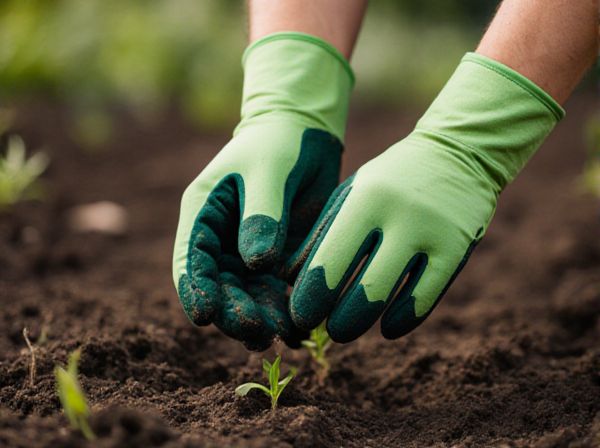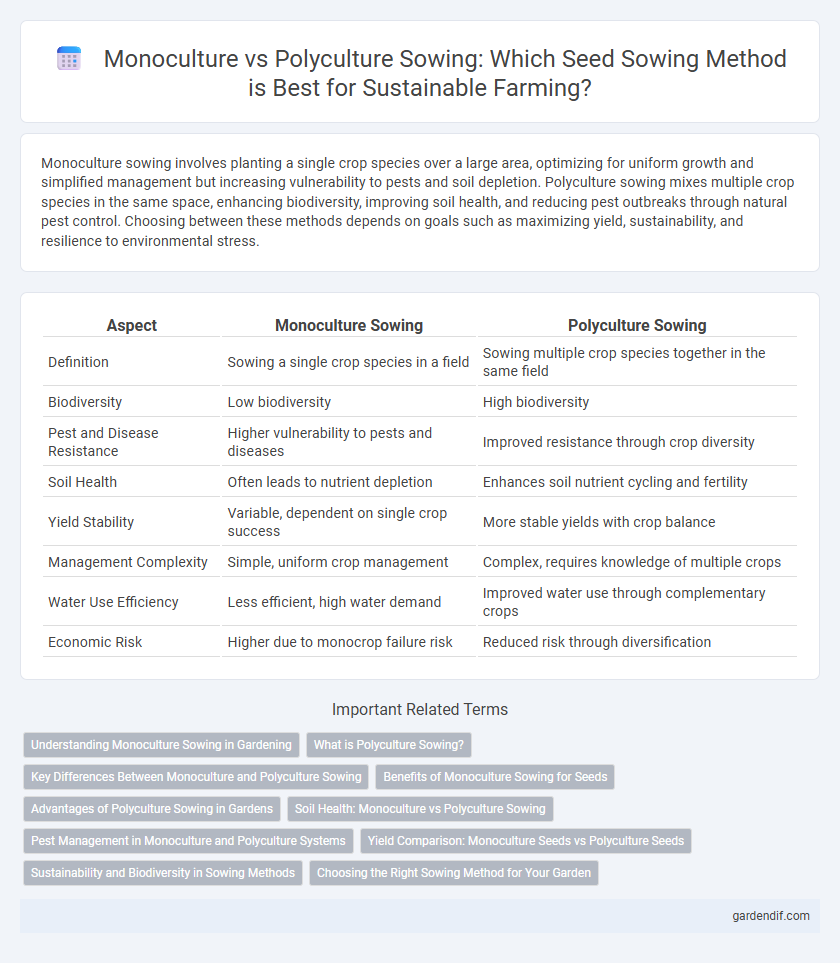
Monoculture sowing vs Polyculture sowing Illustration
Monoculture sowing involves planting a single crop species over a large area, optimizing for uniform growth and simplified management but increasing vulnerability to pests and soil depletion. Polyculture sowing mixes multiple crop species in the same space, enhancing biodiversity, improving soil health, and reducing pest outbreaks through natural pest control. Choosing between these methods depends on goals such as maximizing yield, sustainability, and resilience to environmental stress.
Table of Comparison
| Aspect | Monoculture Sowing | Polyculture Sowing |
|---|---|---|
| Definition | Sowing a single crop species in a field | Sowing multiple crop species together in the same field |
| Biodiversity | Low biodiversity | High biodiversity |
| Pest and Disease Resistance | Higher vulnerability to pests and diseases | Improved resistance through crop diversity |
| Soil Health | Often leads to nutrient depletion | Enhances soil nutrient cycling and fertility |
| Yield Stability | Variable, dependent on single crop success | More stable yields with crop balance |
| Management Complexity | Simple, uniform crop management | Complex, requires knowledge of multiple crops |
| Water Use Efficiency | Less efficient, high water demand | Improved water use through complementary crops |
| Economic Risk | Higher due to monocrop failure risk | Reduced risk through diversification |
Understanding Monoculture Sowing in Gardening
Monoculture sowing in gardening involves planting a single crop species in a specific area, maximizing uniform growth and simplifying management practices such as irrigation and fertilization. This method can increase the risk of pest infestations and soil depletion due to the lack of biodiversity and nutrient variety. Understanding the limitations of monoculture sowing is essential for gardeners aiming to maintain soil health and optimize long-term yield.
What is Polyculture Sowing?
Polyculture sowing involves planting multiple crop species simultaneously in the same area to enhance biodiversity, improve soil health, and reduce pest outbreaks. This method contrasts with monoculture sowing, which grows a single crop species, often leading to decreased soil fertility and higher vulnerability to diseases. Polyculture systems promote sustainable agriculture by maximizing resource use efficiency and increasing resilience to environmental stressors.
Key Differences Between Monoculture and Polyculture Sowing
Monoculture sowing involves planting a single crop species over a large area, promoting high uniformity and ease of management but increasing vulnerability to pests and soil depletion. Polyculture sowing integrates multiple crop species within the same space, enhancing biodiversity, improving soil health, and reducing pest outbreaks due to varied plant interactions. The fundamental difference lies in crop diversity, with monoculture prioritizing uniformity and yield efficiency, while polyculture emphasizes ecological balance and sustainability.
Benefits of Monoculture Sowing for Seeds
Monoculture sowing optimizes seed uniformity and germination rates by providing consistent soil conditions tailored to a single crop species, enhancing overall yield predictability. It simplifies pest and disease management, often resulting in more efficient use of fertilizers and water resources, which directly benefits seed quality and vigor. This method supports large-scale mechanization, reducing labor costs and increasing planting precision for seed production.
Advantages of Polyculture Sowing in Gardens
Polyculture sowing in gardens enhances biodiversity, which naturally reduces pest infestations and improves soil health through complementary plant interactions. This method increases crop resilience and yield stability by mimicking natural ecosystems and promoting beneficial insects and microorganisms. Gardens utilizing polyculture practices often experience reduced dependency on chemical inputs, leading to sustainable and eco-friendly cultivation.
Soil Health: Monoculture vs Polyculture Sowing
Monoculture sowing often depletes soil nutrients rapidly due to the repeated planting of the same crop, leading to increased vulnerability to pests and diseases. Polyculture sowing enhances soil health by promoting nutrient diversity and improved microbial activity, which supports sustainable soil structure and fertility. Integrating multiple crop species in polyculture systems reduces the need for synthetic fertilizers and pesticides, fostering long-term soil resilience.
Pest Management in Monoculture and Polyculture Systems
Monoculture sowing, characterized by the cultivation of a single crop species, often leads to increased vulnerability to pests due to the continuous availability of a preferred host, resulting in higher pest populations and potential outbreaks. In contrast, polyculture sowing, which involves growing multiple crop species simultaneously, enhances pest management by promoting biodiversity that supports natural predators and disrupts pest life cycles, reducing the need for chemical pesticides. This ecological complexity in polyculture systems fosters pest resistance suppression and improves overall crop resilience.
Yield Comparison: Monoculture Seeds vs Polyculture Seeds
Monoculture sowing typically results in higher immediate yields per crop due to specialized seed selection and optimized planting techniques. Polyculture sowing, using a diverse mix of seeds, often leads to more resilient crop systems with stable yields across varying environmental conditions. Yield comparison shows monoculture seeds excel in uniformity and volume, whereas polyculture seeds enhance sustainability and reduce pest risks, impacting long-term productivity.
Sustainability and Biodiversity in Sowing Methods
Monoculture sowing often leads to soil depletion and increased vulnerability to pests, reducing long-term sustainability in agriculture. Polyculture sowing enhances biodiversity by cultivating multiple crop species together, promoting ecosystem resilience and improving soil health. Diverse planting systems support sustainable farming practices by maintaining nutrient cycles and reducing the need for chemical inputs.
Choosing the Right Sowing Method for Your Garden
Monoculture sowing concentrates on planting a single crop species, maximizing space efficiency and simplifying pest management, ideal for gardeners targeting specific yields like tomatoes or corn. Polyculture sowing integrates diverse plant species within the same area, promoting biodiversity, enhancing soil health, and naturally reducing pests through companion planting. Selecting the right sowing method depends on your garden's size, goals, and ecological balance, with monoculture suited for focused production and polyculture enhancing sustainability and crop resilience.
Monoculture sowing vs Polyculture sowing Infographic

 gardendif.com
gardendif.com